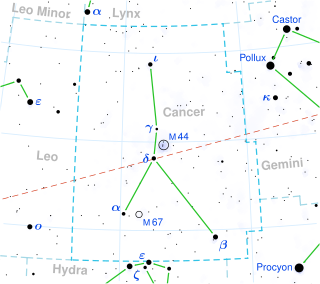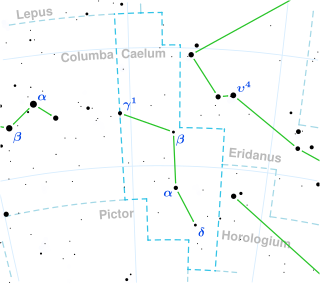
Epsilon Cancri is a white-hued binary star system in the zodiac constellation of Cancer. It is the brightest member of the Beehive Cluster with an apparent visual magnitude of +6.29, which is near the lower limit of visibility with the naked eye. The annual parallax shift of 5.4 mas as seen from Earth yields a distance estimate of approximately 606 light-years from the Sun.

Nu Caeli is a yellow-white hued star in the constellation Caelum. It has an apparent visual magnitude of 6.07, which indicates it is near the lower limit on brightness that is visible to the naked eye. According to the Bortle scale, the star can be viewed from dark suburban skies. Based upon an annual parallax shift of 20.3 mas as seen from Earth, this star is located 161 light years from the Sun.

13 Vulpeculae is a blue giant with a stellar classification of class B9.5III in the northern constellation Vulpecula. It is visible to the naked eye as a faint, blue-white hued star with an apparent visual magnitude of 4.57 and it is approximately 339 light years away from the Sun based on parallax. The star is radiating 180 times the luminosity of the Sun from its photosphere at an effective temperature of 8,801 K.

15 Vulpeculae is a variable star in the northern constellation of Vulpecula, located approximately 243 light years away based on parallax. It has the variable star designation NT Vulpeculae; 15 Vulpeculae is the Flamsteed designation. It is visible to the naked eye as a faint, white-hued star with a typical apparent visual magnitude of 4.66. This object is moving closer to the Earth with a heliocentric radial velocity of −26 km/s.

Xi Leonis is a solitary star in the zodiac constellation of Leo. It has an apparent visual magnitude of 5.0 and is faintly visible to the naked eye. The distance to this star, as determined by parallax measurements, is roughly 229 light years.

HD 204521 is a star in the northern constellation of Cepheus. In the sky it positioned just to the west of the magnitude 3.2 star Beta Cephei. This object has a yellow hue similar to the Sun but is too faint to be visible to the naked eye with an apparent visual magnitude of 7.26. It is located at a distance of 86 light years from the Sun based on parallax, and has an absolute magnitude of 5.15. The star is drifting closer with a radial velocity of −77 km/s, and is predicted to come to within 7.96 light-years in 334,000 years. At that distance the star can have a relatively small perturbing effect on comets in the Oort cloud.

V381 Cephei is a triple star system in the northern constellation of Cepheus. Its apparent magnitude is slightly variable between 5.5 and 5.7.

HD 102839 is a class G6Ib star in the constellation Musca. Its apparent magnitude is 4.98 and it is approximately 1,550 light years away from Earth based on parallax.

π Pavonis, Latinized as Pi Pavonis, is a candidate astrometric binary star system in the constellation Pavo. It is a white-hued star that is visible to the naked eye as a faint point of light with an apparent visual magnitude of 4.33. The distance to this object is 130 light years based on parallax, but it is drifting closer to the Sun with a radial velocity of −15.6 km/s.

Phi1 Pavonis, latinized from φ1 Pavonis, is a single star in the southern constellation of Pavo. It has a yellow-white hue and is faintly visible to the naked eye with an apparent visual magnitude of 4.75. The star is located at a distance of approximately 92 light years away based on parallax. It is drifting closer to the Sun with a radial velocity of −20 km/s.

Rho Pavonis, Latinized from ρ Pavonis, is a single, variable star in the southern constellation of Pavo. It is yellow-white in hue and faintly visible to the naked eye with an apparent visual magnitude that fluctuates around 4.86. The star is located at a distance of approximately 190 light years from the Sun based on parallax, and is drifting further away with a radial velocity of +8 km/s. It is a candidate outlying member of the Tucana Association of co-moving stars.

κ Phoenicis, Latinized as Kappa Phoenicis, is a single star in the southern constellation of Phoenix. It is visible to the naked eye as a white-hued point of light with an apparent visual magnitude of 3.94. The distance to this star is approximately 77.7 light years based on parallax, and it is drifting further away with a radial velocity of +11 km/s. It is a member of the Castor Moving Group of co-moving stars.

V Puppis is a star system in the constellation Puppis. Its apparent magnitude is 4.41. There is a binary star system at the center with a B1 dwarf orbiting a B3 subgiant star. They have an orbital period of 1.45 days and a distance of only 15 solar radii apart. However, the system moves back and forth, indicating that there is a massive object orbiting them with a period around 5.47 years. Based on the mass of the object, its lack of a visible spectrum, and circumstellar matter in the system with many heavy elements, it is probably a black hole. However, a follow-up study could not confirm this object, but found signs that there may be a third object which is fainter than the other components.

QW Puppis is a class F3V star in the constellation Puppis. Its apparent magnitude is 4.49 and it is approximately 69.5 light years away based on parallax.

1 Puppis is a single star in the southern constellation of Puppis. It lies in the northern part of the constellation at a distance of about 790 ly, east of Aludra in Canis Major and just north of the white supergiant, 3 Puppis. This object is visible to the naked eye as a faint, red-hued star with an apparent visual magnitude of 4.59. It is moving further from the Earth with a heliocentric radial velocity of +32.4 km/s.

HD 59890 is a class G3Ib yellow supergiant star in the constellation Puppis. Its apparent magnitude is 4.65 and it is approximately 1,360 light years away based on parallax.

MX Puppis is a class B1.5IV star in the constellation Puppis. Its apparent magnitude varies irregularly between magnitude 4.6 and 4.9 and it is classified as a Gamma Cassiopeiae variable. It is approximately 930 light years away based on parallax.

HD 54893, often called A Puppis is a suspected variable star in the constellation Puppis. Its apparent magnitude is 4.83 and is approximately 860 light years away based on parallax.

HD 70555 is a class K2.5II-III star in the constellation Puppis. Its apparent magnitude is 4.83 and it is approximately 1,010 light years away based on parallax.
36 Camelopardalis is a single star in the northern circumpolar constellation of Camelopardalis. It is visible to the naked eye as a dim point of light with an apparent visual magnitude of +5.3. Parallax measurements provide a distance estimate of approximately 710 light years away from the Sun, and it is drifting away from the Earth with a radial velocity of −1.15 km/s.










